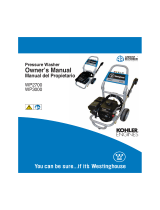
5
TABLE OF CONTENTS
CONGRATULATIONS ON OWNING A WESTINGHOUSE PRESSURE WASHER ...........................................3
For Your Records ..........................................................................................................................................3
Product Registration .....................................................................................................................................3
Product Registration Form ............................................................................................................................3
SAFETY ....................................................................................................................................................................7
SAFETY DEFINITIONS ......................................................................................................................................7
SAFETY SYMBOL DEFINITIONS ......................................................................................................................7
GENERAL SAFETY RULES ...............................................................................................................................8
SAFETY LABELS AND DECALS .....................................................................................................................10
WP2300 ......................................................................................................................................................10
WP2500 ......................................................................................................................................................11
UNPACKING ...........................................................................................................................................................12
UNPACKING THE PRESSURE WASHER ........................................................................................................12
COMPONENTS ................................................................................................................................................12
ASSEMBLY .............................................................................................................................................................13
ASSEMBLY .......................................................................................................................................................13
FEATURES .............................................................................................................................................................16
GENERAL PRESSURE WASHER FEATURES ................................................................................................16
OPERATION ...........................................................................................................................................................18
BEFORE STARTING THE PRESSURE WASHER ...........................................................................................18
ADDING / CHECKING ENGINE FLUIDS AND FUEL .......................................................................................18
Checking and / or Adding Engine Oil ..........................................................................................................18
Adding Gasoline to the Fuel Tank ...............................................................................................................19
CONNECTING THE WATER SUPPLY ..............................................................................................................19
STARTING THE PRESSURE WASHER ...........................................................................................................20
STOPPING THE PRESSURE WASHER ..........................................................................................................21
Normal Operation .......................................................................................................................................21
During an Emergency .................................................................................................................................21
SELECTING NOZZLES ....................................................................................................................................22
Changing the Nozzle ..................................................................................................................................23
SPRAYING TIPS ...............................................................................................................................................23
SPRAYING SOAP .............................................................................................................................................24
RINSING ...........................................................................................................................................................24
CLEANING SOAP SIPHON HOSE ...................................................................................................................24
MAINTENANCE ......................................................................................................................................................25
MAINTENANCE ................................................................................................................................................25
Maintenance Schedule ...............................................................................................................................25
ENGINE OIL MAINTENANCE ..........................................................................................................................26
Engine Oil Specifi cation ..............................................................................................................................26
Checking Engine Oil ...................................................................................................................................26
Adding Engine Oil .......................................................................................................................................27
Changing Engine Oil ...................................................................................................................................27
AIR FILTER MAINTENANCE ............................................................................................................................27
Cleaning the Air Filter .................................................................................................................................27
SPARK PLUG MAINTENANCE ........................................................................................................................29
PRESSURE WASHER COMPONENTS ...........................................................................................................30
Water Filter Screen .....................................................................................................................................30
High-Pressure Hose and Spray Gun ..........................................................................................................30
High-Pressure Hose .............................................................................................................................30
Spray Gun ............................................................................................................................................30
Soap Siphon Hose ......................................................................................................................................30
Nozzle .........................................................................................................................................................30
AFTER EACH USE ...........................................................................................................................................31
LONG-TERM STORAGE ..................................................................................................................................31
Storage Procedure for 1 – 3 Months ...........................................................................................................31
Storage Procedure for Greater Than 3 Months ..........................................................................................31























